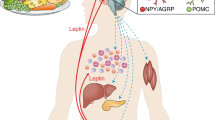Abstract
Obesity is a global public health problem linked to increased risk for many disorders including diabetes, cardiovascular disease, and even cancer. The World Health Organization estimates almost two billion adults worldwide are considered overweight with nearly 600 million of those individuals also being considered obese. How did we get here? The laws of thermodynamics would suggest it is simply a fact that we consume too many calories without burning an equal number, thus causing an imbalance that results in weight gain and eventual obesity. Such a situation would thus be easy to address, since simply reducing caloric intake would eliminate the problem. However, the story is far more complex and involves the interplay between both central and peripheral systems that regulate energy metabolism, energy consumption, and even the brain’s reward circuitry. This chapter will explore the peripheral signals that not only contribute to obesity but also make it difficult for us to break the cycle that leads to metabolic dysregulation and obesity. We will specifically consider obesity in the context of the brain, which coordinates feeding, activity, circadian rhythms, and metabolic functions, while also being a target for many metabolic hormones. Thus, the state of being obese leads to changes not only in the periphery but also centrally within the brain. How this affects brain structure and function will also be discussed.
Similar content being viewed by others
References
Andresen MC et al (2004) Differentiation of autonomic reflex control begins with cellular mechanisms at the first synapse within the nucleus tractus solitarius. Braz J Med Biol Res 37(4):549–558
Berthoud H-R, Zheng H (2012) Modulation of taste responsiveness and food preference by obesity and weight loss. Physiol Behav 107(4):527–532
Cooper MS, Seibel MJ, Zhou H (2015) Glucocorticoids, bone and energy metabolism. Bone 82:64–8
Dallman MF (2010) Stress-induced obesity and the emotional nervous system. Trends Endocrinol Metab 21(3):159–165
Dorfman MD, Thaler JP (2015) Hypothalamic inflammation and gliosis in obesity. Curr Opin Endocrinol Diabetes Obes 22(5):325–330
Friedman JM, Halaas JL (1998) Leptin and the regulation of body weight in mammals. Nature 395(6704):763–770
Gao Q, Horvath TL (2007) Neurobiology of feeding and energy expenditure. Annu Rev Neurosci 30(1):367–398
Giduck SA, Threatte RM, Kare MR (1987) Cephalic reflexes: their role in digestion and possible roles in absorption and metabolism. J Nutr 117(7):1191–1196
Grill HJ, Hayes MR (2012) Hindbrain neurons as an essential hub in the neuroanatomically distributed control of energy balance. Cell Metab 16(3):296–309
Ha M, Park J (2005) Shiftwork and metabolic risk factors of cardiovascular disease. J Occup Health 47(2):89–95
Hastings MH, Reddy AB, Maywood ES (2003) A clockwork web: circadian timing in brain and periphery, in health and disease. Nat Rev Neurosci 4(8):649–661
Labouebe G et al (2013) Insulin induces long-term depression of ventral tegmental area dopamine neurons via endocannabinoids. Nat Publ Group 16(3):300–308
Marcheva B et al (2010) Disruption of the clock components CLOCK and BMAL1 leads to hypoinsulinaemia and diabetes. Nature 466(7306):627–631
Ritter RC (2004) Gastrointestinal mechanisms of satiation for food. Physiol Behav 81(2):249–273
Silvestri C, Di Marzo V (2013) The endocannabinoid system in energy homeostasis and the etiopathology of metabolic disorders. Cell Metab 17(4):475–490
Author information
Authors and Affiliations
Corresponding author
Editor information
Editors and Affiliations
Rights and permissions
Copyright information
© 2016 Springer Science+Business Media New York
About this entry
Cite this entry
Karatsoreos, I., Peters, J. (2016). Obesity: Peripheral Signals, Neural and Peptidergic. In: Pfaff, D., Volkow, N. (eds) Neuroscience in the 21st Century. Springer, New York, NY. https://doi.org/10.1007/978-1-4614-6434-1_155-1
Download citation
DOI: https://doi.org/10.1007/978-1-4614-6434-1_155-1
Received:
Accepted:
Published:
Publisher Name: Springer, New York, NY
Online ISBN: 978-1-4614-6434-1
eBook Packages: Springer Reference Biomedicine and Life SciencesReference Module Biomedical and Life Sciences
Publish with us
Chapter history
-
Latest
Obesity: Peripheral Signals, Neural and Peptidergic- Published:
- 26 July 2022
DOI: https://doi.org/10.1007/978-1-4614-6434-1_155-2
-
Original
Obesity: Peripheral Signals, Neural and Peptidergic- Published:
- 11 March 2016
DOI: https://doi.org/10.1007/978-1-4614-6434-1_155-1




